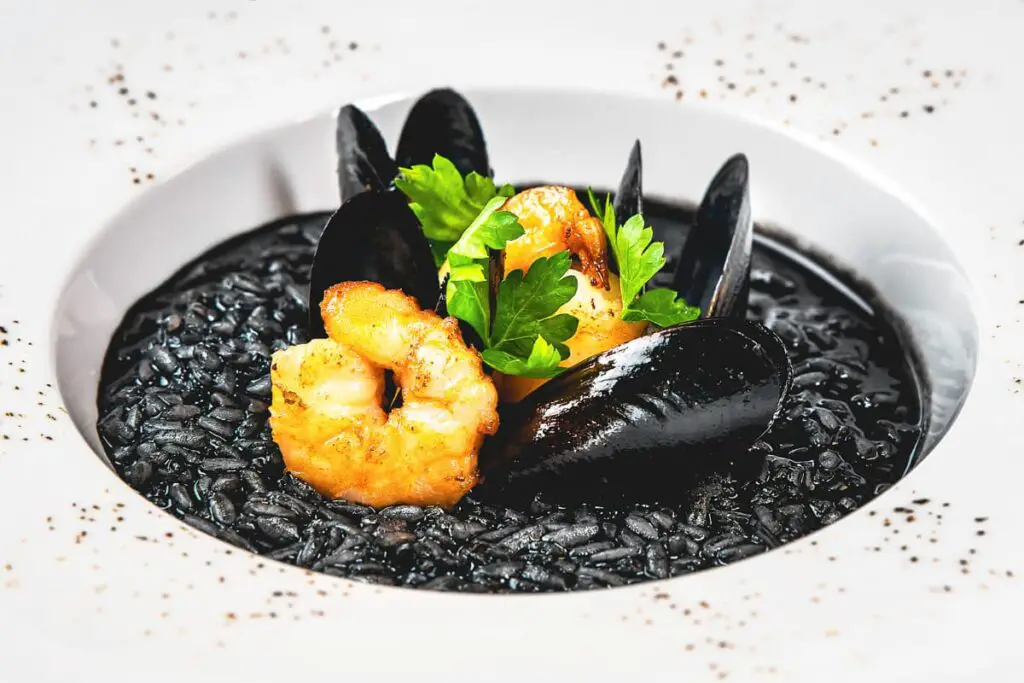Have you ever heard of an octopus using ink as a defense mechanism? It’s true! These clever cephalopods have a secret weapon up their tentacles that they use to protect themselves from predators.
Is Octopus Ink Toxic or Poisonous?
Octopus ink is not considered dangerous to people. In some parts of the world, such as Japan and Italy, squid and octopus ink are used as a flavoring and a natural food coloring for various dishes.
Generally, the ink contains a mix of melanin, mucus, and other substances that can create a dark cloud to obscure an octopus’s rapid escape.
However, some species of octopus produce ink that contains tyrosinase, an enzyme that can cause a burning sensation in the eyes and gills of predators. For this reason, you wouldn’t want to swim through octopus ink, since it could create discomfort if it came into contact with your eyes.
Squid and Octopus Ink: Composition and Function
Is Octopus Ink the Same as Squid Ink?
While both octopuses and squids are cephalopods, there are subtle differences between their inks. Octopus ink is slightly more viscous than squid ink, but both contain pigments, melanin, and mucus.
Ink Sac and Pigments
Both squids and octopuses possess ink sacs, which store the ink used for defense. The primary pigment responsible for the dark color of cephalopod ink is melanin. This pigment is also found in human skin, hair, and eyes.
Melanin in cephalopod ink sacs is packed within small ink granules, which are suspended in a liquid medium.
Predator Defense Mechanism
In a flash, the octopus releases a cloud of dark ink that billows out behind it like a smokescreen. This ink not only confuses and disorients predators, but it also helps the octopus to make a quick escape.
But how does it work? When an octopus feels threatened, it can contract special muscles in its ink sac to force the ink out through a small opening. The ink is made up of a mixture of melanin, mucus, and other chemicals, which gives it its dark color and sticky texture.
Once the ink is released, it quickly spreads out in the water, creating a dark cloud that makes it difficult for predators to see the octopus. This gives the octopus time to make a getaway while the predator is distracted by the ink.
Here’s how the process works:
- Step 1: The cephalopod detects a threat and signals its ink sac to release ink.
- Step 2: The ink mixes with sea water, creating a cloud that can obscure the predator’s vision.
- Step 3: Mucus in the ink can cause the predator’s sensory organs to become temporarily impaired, adding to the confusion.
- Step 4: The cephalopod makes its escape, while the predator is occupied with the ink cloud.
Cephalopod Ink in Water
When released into the water, cephalopod ink can rapidly disperse due to its unique composition and the presence of mucus. This dispersion helps to create a larger, more effective cloud for the predator to contend with.
The melanin in the ink can also absorb light, further obscuring the area around the cephalopod. Overall, the combination of melanin, mucus, and water creates an effective defense against predators.
Does Octopus Ink Contain Poison or Toxins?
Have you ever wondered what makes octopus ink so effective at confusing and disorienting predators? It turns out that the secret lies in the chemistry of the ink itself.
Octopus ink is made up of a complex mixture of chemicals, including melanin, mucus, and other compounds. Melanin is the same pigment that gives our skin and hair its color, and it is also found in the ink sacs of many cephalopods, including octopuses. In fact, melanin is what gives octopus ink its dark color and opaque appearance.
But melanin is just one of many chemicals found in octopus ink. The ink also contains mucus, which helps to give it a sticky texture and allows it to spread out quickly in the water. This stickiness can be especially effective at trapping small predators, like fish and crustaceans, that might try to attack the octopus.
In addition to melanin and mucus, octopus ink also contains a variety of other compounds that can have different effects on predators.
For example, some species of octopus produce ink that contains high levels of tyrosinase, an enzyme that can cause a burning sensation in the eyes and gills of predators. This can be a powerful deterrent, as it can cause the predator to back off and give the octopus time to escape.
But perhaps the most interesting chemical found in octopus ink is a compound called L-dopa. This chemical is a precursor to dopamine, a neurotransmitter that is responsible for regulating mood and behavior in many animals, including humans.
When an octopus releases ink, it can cause a cloud of L-dopa to spread out in the water, which can have a calming effect on other animals in the area (Huffard et al. 2005). This can be especially useful for octopuses that are trying to avoid predators, as it can help to reduce the aggression of nearby fish and other animals.
Dangerous Cephalopod Species
It is important to note that the danger associated with these creatures does not stem from their ink.
While the ink of most octopuses is not harmful, some species do pose a threat to humans. The blue-ringed octopus is renowned for its potent venom, which can lead to paralysis and even death if not treated promptly.
Culinary Uses of Squid and Octopus Ink
How Does Octopus and Squid Ink Taste
The ink of octopus and squid has a unique taste which can be described as briny, salty, and slightly metallic. It contains amino acids like taurine, aspartic acid, and alanine, which contribute to its flavor profile.
The taste is subtle, yet distinct, and enhances the overall flavor of dishes instead of overpowering them.
Safety and Edibility
Squid and octopus ink are considered safe to eat and are not toxic or poisonous. However, some people might have allergies or sensitivities to specific components of the ink, such as copper.
It is important to ensure the ink is properly handled and sourced from reputable suppliers to guarantee its safety and quality.
Popular Dishes and Cuisines

In many Mediterranean and Japanese cuisines, squid and octopus ink are used as a flavoring and a natural food coloring for various dishes. Some popular examples include:
- Pasta: In Italy, squid ink is often used to create black-colored pasta, giving it a rich and bold appearance.
- Risotto: A traditional Greek and Mediterranean dish, risotto is sometimes made with squid or octopus ink to amplify its taste and visual appeal.
- Sauces: In Japanese cuisine, the ink is combined with other ingredients to create savory sauces, complementing dishes like sushi and tempura.
Cooking Techniques and Flavor Enhancements
To incorporate squid or octopus ink into your cooking, begin with a small amount and adjust based on taste preferences.
The ink can be mixed directly into pasta dough, rice, or sauces. Alternatively, it can be used as a finishing touch by drizzling it on top of dishes for a dramatic presentation.
The ink’s flavor is versatile and pairs well with various ingredients such as seafood, vegetables, and spices. In addition, combining the ink with lemon juice, garlic, or white wine can enhance its flavor profile.
Natural Food Coloring in Cooking
In addition to its culinary benefits, squid and octopus ink can be used as a natural food dye, giving dishes a striking appearance while avoiding artificial coloring agents. It works particularly well in:
- Eggs: Scrambled eggs, omelettes, and frittatas can be tinted with squid or octopus ink for an eye-catching dish.
- Bread: Incorporating ink into bread dough results in an exciting twist on traditional loaves or rolls.
- Desserts: Though less common, adventurous chefs can experiment with using the ink to add a dark hue to sweet treats such as ice cream or frosting.
Utilizing squid and octopus ink in cooking is an inventive way to enhance both the taste and appearance of various dishes, while also benefiting from its natural food coloring properties.
Other Applications and History

Ink as Writing Material
Historically, octopus ink was used in some cultures as a writing material. In Japan, for example, this ink served as an alternative to traditional ink made from plant materials.
Octopus ink is rich in enzymes and pigments that provide a dark, intense color perfect for writing and drawing. It’s also capable of maintaining its texture and consistency regardless of temperature and humidity.
Chemotherapy Research
Recent research has shown that certain components in octopus ink may hold promise in the development of new chemotherapy drugs. The ink contains tyrosinase, an enzyme with potential for inhibiting the growth of cancer cells.
Additionally, polysaccharides found in the ink have been shown to possess anti-tumor properties. This information has spurred researchers to continue exploring the potential uses of octopus ink in cancer treatment and drug development.
Octopus Ink in Folklore and Culture
Octopus ink also has a significant presence in folklore and culture around the world.
In Japan, it is considered a symbol of intelligence and wisdom, making it a popular subject in traditional art and storytelling. In some regions, it is even believed that consuming octopus ink can help regulate blood pressure and improve overall health.
Octopus Ink and Marine Life
Ink Interaction with Chemosensory Systems of Predators and Prey
Octopus ink has a significant effect on the chemosensory systems of both predators and prey.
Marine animals such as crabs and snails rely heavily on their sense of smell to navigate their surroundings and locate food sources. When cephalopods like octopus and cuttlefish release ink, it interferes with these chemosensory systems, making it difficult for predators to locate and capture their intended targets.
The ink is composed of substances like l-dopa, glutamic acid, and lysine, which are known to disrupt chemosensory systems in some marine creatures. Additionally, the dense pigments in the ink provide visual concealment, further confounding the efforts of predators.
Variations in Defense Strategies Among Cephalopods
Cephalopods, including octopus, cuttlefish, and some species of squid, have developed a variety of defense mechanisms that utilize their ink in different ways. Some of these include:
- Pseudomorphs: Pseudomorphs are ink formations released by cephalopods that resemble their own shape and size. These decoys trick predators into attacking the ink cloud rather than the actual cephalopod, allowing the latter to escape.
- Ink ropes: A less common strategy seen in certain species like cirrina is the release of ink ropes. These long, twisted strands of ink create a confusing visual barrier, further deterring predators.
- Diffuse puffs: This tactic involves releasing a cloud of ink that diffuses rapidly in the water, providing a temporary, disorienting smokescreen.
- Mantle fills: Some cephalopods, such as cuttlefish, fill their mantle cavities with ink before rapidly expelling it in a high-pressure jet. This creates a sudden burst of color and confusion, known as the blanch-ink-jet maneuver, allowing them to escape without being noticed.
Different cephalopod species have been observed employing a combination of these strategies, like pseudomorph series, wherein the animal releases a series of ink decoys while rapidly altering their own appearance to blend in with the background.
References
Huffard, C. L., Caldwell, R. L., & Boneka, F. (2005). Locomotion by Abdopus aculeatus (Cephalopoda: Octopodidae): walking the line between primary and secondary defenses. Journal of Experimental Biology, 208(16), 3073-3080.


